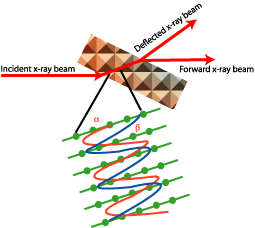Switching hard x-ray beams on and off rapidly enough to capture the motion of atoms is the goal of one research project under way at the MHATT-CAT beamlines at Argonne National Laboratory's Advanced Photon Source. Perfecting this technique may enable the development of a sub-picosecond x-ray switch fast enough to track dynamic changes in molecular structure during chemical and biochemical reactions.
The production and application of sub-picosecond x-ray sources is currently a very active research topic. Several different approaches utilizing ultrafast lasers are being investigated. These include laser-plasma sources that produce short pulses of Bremsstrahlung and line emission; Thompson scattering of lasers off of relativistic electron beams; and, ponderomotive scattering of stored electrons in a synchrotron from an intense laser. Future, linear accelerator based sources will be able to support short electron pulses and thus produce ultrafast x-ray pulses directly in an undulator.
The x-ray "switch" technique developed by researchers from the University of Michigan, Argonne, and Colby College takes advantage of the high brightness of synchrotrons such as the APS without extensively modifying them from their original design. It is elegantly simple and highly adaptable: It uses a femtosecond laser to coherently perturb the structure of a suitably chosen crystal on the time-scale of lattice vibration. By precisely synchronizing the excitation with the x-ray pulse train, the switch described here is cable of extracting a thin sliver from a single ~100ps long APS x-ray bunch. The switch consists of a specially cut and aligned germanium crystal that is placed in the path of a high-brilliance x-ray beam in the Borrmann geometry in order to produce two diffracted beams at the exit of the crystal. This crystal is coherently excited with a femtosecond laser pulse, resulting in acoustic phonon excitation that transiently rearranges the atoms in the crystal lattice. This changes the transmission of the incident x-ray beam redistributing energy between the two exiting beams. By simply varying the time-delay between the x-rays and the laser, the researchers are able switch them on and off or change their relative strengths. An even faster switch might result from perturbation of the electron distribution around atoms in the crystal lattice or through the use of optical rather than acoustic modes of lattice vibration (one period is typically ~ 30fs).
M. F. DeCamp,(1) D. A. Reis,(1) P. H. Bucksbaum,(1) B. Adams,(2) J. M. Caraher,(1) R. Clarke,(1) C. W. S. Conover,(3) E. M. Dufresne,(1) R. Merlin,(1) V. Stoica,(1) and J. K. Wahlstrand(1)
(1) Department of Physics and FOCUS Center, University of Michigan
(2) Advanced Photon Source, Argonne National Laboratory
(3) Colby College, Maine
For more on this subject, see Nature 413, 825-828 (2001)
Correspondence and requests for materials should be addressed to M.F.DeCamp.
Use of the Advanced Photon Source was supported by the US Department of Energy Basic Energy Sciences, Office of Energy Research. We also acknowledge partial support from the National Science Foundation, the Center for Ultrafast Optical Science, and the AFOSR through the MURI programme.

